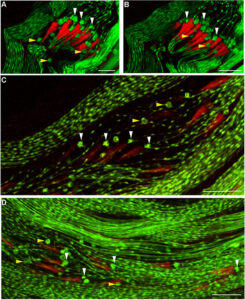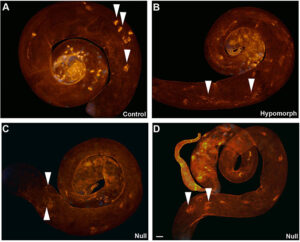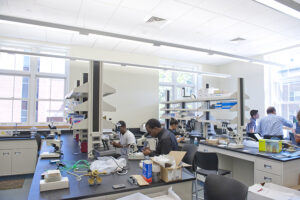They’ve Done It Again: Mount Researchers Published
4/9/2020
Dr. Fabrizio, Undergraduate Students Collaborate to Conduct Groundbreaking, Years-Long Study
The last few years have been busy for James Fabrizio and his student researchers.
Their time in the lab has culminated with the publication of a major peer-reviewed research paper, featuring 18 Mount Saint Vincent student co-authors, led by Professor of Biology and Jean Ames DeNunzio Chair of Faculty Excellence, Dr. Fabrizio. The paper, Tubulin-binding cofactor E-like (TBCEL), the protein product of the mulet gene, is required in the germline for the regulation of inter-flagellar microtubule dynamics during spermatid individualization, was published in Biology Open (BIO).
Many of Dr. Fabrizio’s student collaborators have since graduated from the College. His exceptional co-authors and researchers include: Vrutant Patel ’14, Kavita Bharrat ’15, Dwaine Pryce ’15, Rachel Daniel ’16, Elissa Innabi ’16, Iryna Koziy ’16, Vincent Lombardo ’16, Elisa Ferrara ’17, Gabriela Mendoza ’17, Stephanie Rodway ’17, Matthew Vicioso ’17, Marielle Villanobos ’17, Erin Dailey ’18, Simon Innabi ’18, Justin Pronovost ’18, Victoria Siracusa ’18, Nicole DeSouza ’19, and Danielle Quaranto ’20.

Dr. Fabrizio has collaborated with students on his research ever since he joined the University of Mount Saint Vincent faculty in 2002.
“What makes my research unique is that the great majority of the experiments are performed here, on campus, by Mount Saint Vincent undergraduate research students under my supervision and mentorship,” he said. “At first, the students generally focus on technique and analysis, but as they spend more time in the lab, they begin to ask scientific questions, formulating their own hypotheses and sometimes designing their own experiments. The more time they spend on a project, the more they develop as junior scientists. This type of apprenticeship is how Ph.D. candidates in the biomedical sciences are trained in graduate school.”
And this specific project has been in the works since 2015.
“Each year, I get a new crop of students to address another piece of the puzzle,” Dr. Fabrizio said. “Altogether, the project took four years and it’s not over—every answer in science leads to more questions.”

Mitochondrial dynamics in mulet mutant testes as revealed by don juan-GFP (dj-GFP).
The impetus behind creating the now-published research study was based on Dr. Fabrizio’s lab studies on sperm development (spermatogenesis) and male infertility.
“While there are clinical applications to the findings, the main reason we do the work is because it’s fun,” he said. “I just love to investigate how genes (like our mulet gene) actively transform from a tiny nondescript little round cell into a two-millimeter-long swimming sperm (fruit fly sperm are gigantic, as long as the fly itself)! That is the thrill of science and research.”
“The leading cause of male infertility is a failure at the very end of spermatogenesis,” Dr. Fabrizio continued. “Our lab studies a gene—mulet—that controls this final stage of spermatogenesis. We use the fruit fly, Drosophila melanogaster, as a model organism to study this process. Drosophila is an exceptional organism for biological research: It is easy to maintain in the laboratory, possesses strong mutational genetics, a sequenced genome, and approximately 65 percent genetic homology to human beings.”
Dr. Fabrizio further explained that he and his student researchers can easily use Drosophila to study spermatogenesis and due to the fruit fly’s genetic similarity to humans, the results they obtain apply directly to human spermatogenesis and fertility.

Hypomorphic and amorphic mulet mutant males exhibit
counterintuitive individualization phenotypes.
Their project’s objectives have been to characterize mutations in the mulet gene using specific molecular markers and electron microscopy and to determine exactly where the mulet is required during spermatogenesis.
Dr. Fabrizio believes this study is significant because it is a piece of original scholarship created by undergraduate students through a partnership unique to the College. This feat is uncommon for students on the undergraduate level—but not at the Mount.
“The students literally created knowledge with this project—they discovered something,” he said. “We know more about how to make a sperm cell because of work done at our College by our students. The Mount is not only a place where students learn, but it is a place where students design, hypothesize, create, analyze, discover, synthesize, and produce.”

Dr. Fabrizio also enlisted the help of Associate Professor of Mathematics, Amir Niknejad, and two of his students: Senior biochemistry major Danielle Quaranto—who’s not only a member of the College’s Honors Program, but also minors in mathematics—and recent graduate Nicole DeSouza ’19, who studied biology with a minor in mathematics and chemistry. Together, they performed all the statistical analyses in the paper. Additionally, he asked Associate Professor of Chemistry, Janet Rollins, to offer her expertise in electron microscopy. She generated all of the electron micrographs presented in the study.
“When raw data is generated in the lab, it has to be processed using statistics to determine its significance,” Dr. Fabrizio stated. “I called upon Dr. Niknejad because he is the statistics professor on campus and our resident expert. Nicole and Danielle are not only star students, but are also science majors, easily bridging the gap between biology and mathematics.”
Danielle and Nicole had been conducting research at the Zuse Institute in Germany—a research institute for applied mathematics and computer science on the campus of Freie Universität Berlin—for six weeks following the 2019 spring semester, and that’s when Dr. Fabrizio contacted his colleague to help him figure out statistics calculations for the research data for his study.
“Nicole and I spent our time creating a mathematical model system that analyzed the dysregulation of BMP (bone morphogenetic protein) signal transduction in its wild type and mutated state and how it relates to the disease FOP (Fibrodysplasia ossificans progressiva),” Danielle said. “We utilized Matlab software to generate a matrix model to analyze the various states of the system using Singular Value Decomposition.”
Dr. Fabrizio needed the students’ statistics and mathematics knowledge to help him elaborate on his own scientific data.
“Doing research in Germany and working on Dr. Fabrizio’s paper helped me hone my statistics skills and showed me the mathematics side of science,” Danielle continued. “While working on Dr. Fabrizio’s paper, we used mathematics to explain the science behind a particular disease and I was able to see the work that it takes to get published in science. It’s not all scientific data analysis and writing, there’s mathematical analysis that needs to go into a scientific paper as well.”
Experiential, collaborative laboratory research that undergraduate Mount studentsspec conduct is extremely significant. Just take it from Dr. Fabrizio: “The best way to learn science is to do science. This type of training prepares our students to be better independent thinkers, problem solvers, and communicators of complex ideas. In essence, this is what Mount Saint Vincent is all about.”
About the University of Mount Saint Vincent
Founded in 1847 by the Sisters of Charity, the University of Mount Saint Vincent offers nationally recognized liberal arts education and a select array of professional fields of study on a landmark campus overlooking the Hudson River. Committed to the education of the whole person, and enriched by the unparalleled cultural, educational, and career opportunities of New York City, the College equips students with the knowledge, skills, and experiences necessary for lives of achievement, professional accomplishment and leadership in the 21st century.
